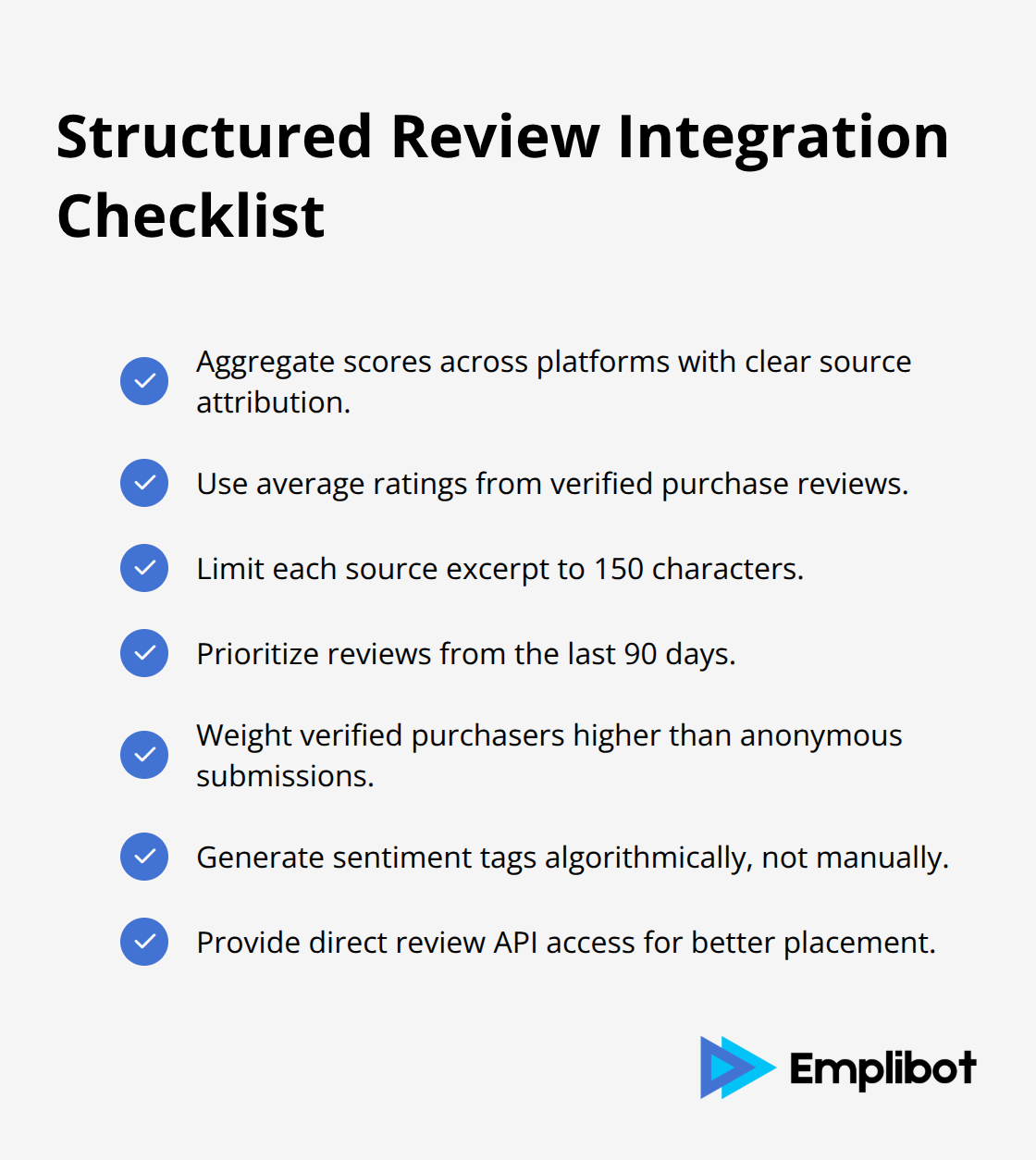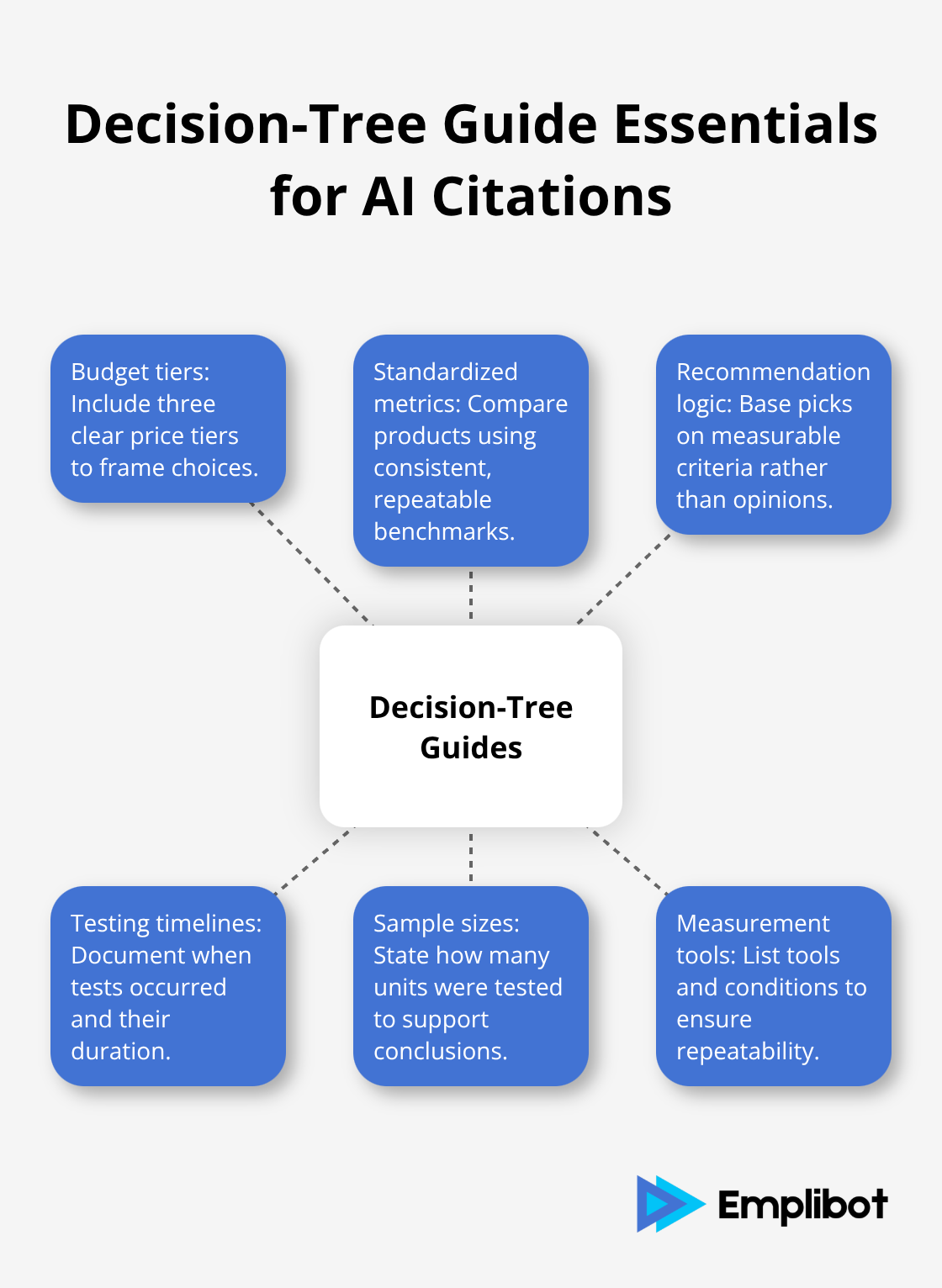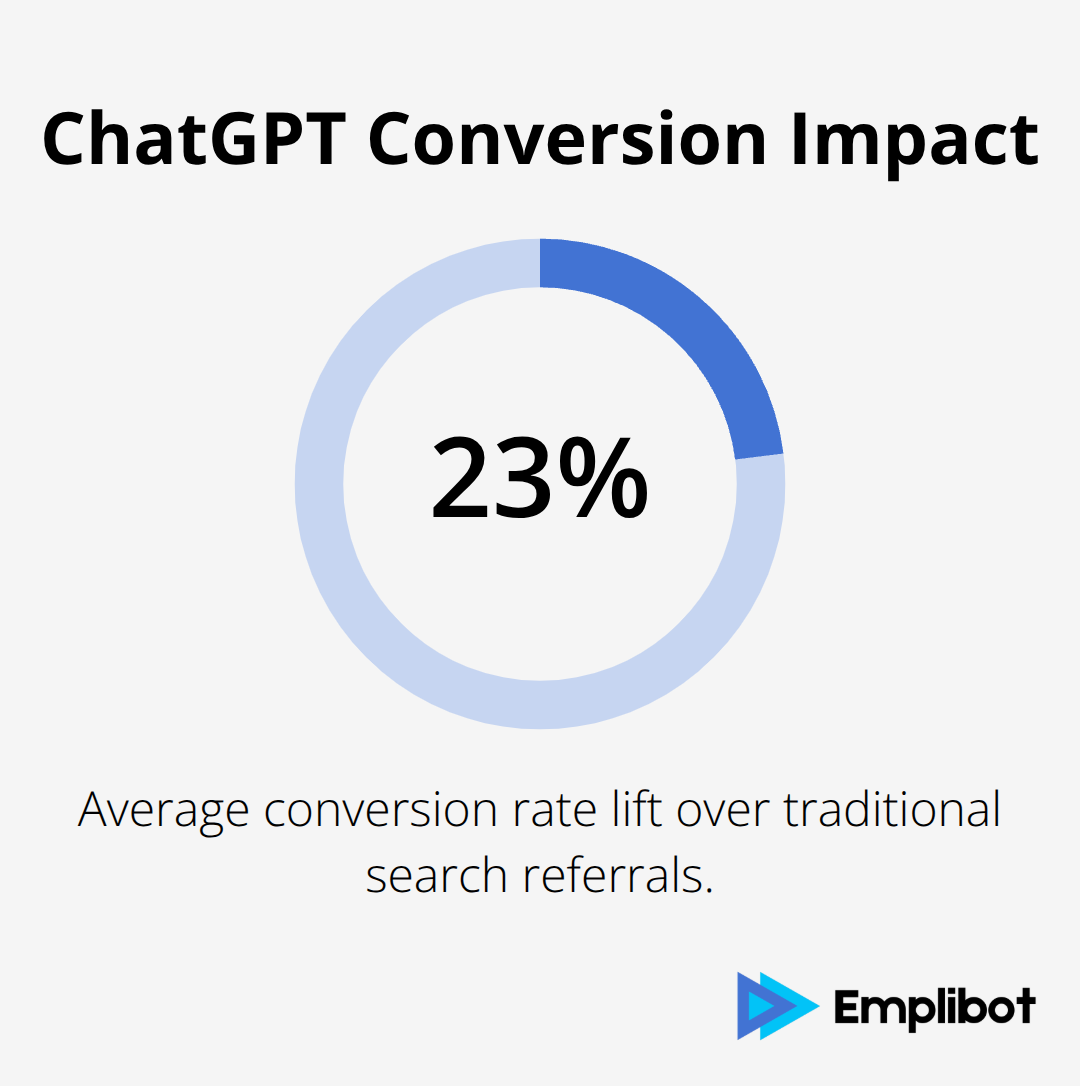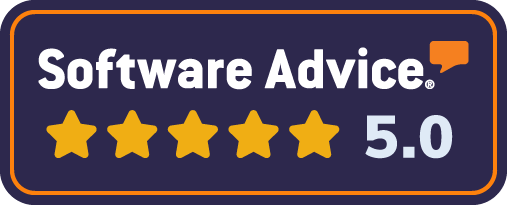OpenAI launched ChatGPT search and shopping features that display product recommendations with images, reviews, and direct purchase links. The platform shows organic results without paid placements, creating new opportunities for brands.
We at Emplibot see this as a major shift in product discovery. Getting your products visible in ChatGPT requires specific data optimization and content strategies that most retailers haven’t implemented yet.
Contents
ToggleHow ChatGPT Shopping Actually Works
ChatGPT shopping operates through three integrated systems that fundamentally change how products get discovered online. The platform displays product recommendations with high-resolution images, aggregated review scores, and direct merchant links when users express intent to buy. OpenAI processes 700 million weekly active users, making this the largest AI-powered commerce platform by volume.
Product Display and Ranking Algorithm
ChatGPT ranks products based on availability, price competitiveness, and merchant quality scores rather than ad spend. The system pulls structured data from merchant feeds, third-party product databases, and public review sites to create normalized product cards. Each product display includes simplified titles, price comparisons across multiple retailers, and review summaries that highlight common user feedback patterns. The algorithm prioritizes merchants with direct API connections and real-time inventory feeds over scraped data sources.
Search Integration and Discovery Patterns
The ChatGPT search upgrade connects results with conversational queries through contextual analysis. Users who ask about specific product categories or comparison requests trigger the interface automatically. The system maintains user preferences through Memory features and Custom Instructions, which allows for personalized product filters based on budget constraints, brand preferences, and past purchase behavior. Product discovery happens organically within conversations rather than through traditional search result pages (creating higher engagement rates for featured merchants).
Direct Purchase and Merchant Integration
Instant Checkout functionality enables single-click purchases through partnerships with payment processors like Stripe and merchant platforms such as Shopify and Etsy. Over one million Shopify merchants now have access to ChatGPT integration through the Agentic Commerce Protocol, which requires minimal technical implementation. Merchants maintain complete control over customer relationships and transaction data while they pay small fees only on completed purchases. The system uses encrypted payment tokens and merchant-specific authorization to process transactions securely without it stores sensitive customer payment information.
This technical foundation creates specific requirements for product data optimization that most retailers haven’t addressed yet.
What Product Data Format Does ChatGPT Require
ChatGPT processes product information through structured data schemas that prioritize consistency over complexity. The platform expects normalized attribute sets that include product titles under 60 characters, standardized category classifications, and technical specifications formatted as key-value pairs. Price data requires ISO currency codes, availability status updates within 15 minutes, and merchant identification numbers linked to verified business accounts. Products without these normalized attributes receive lower visibility scores in ChatGPT rankings, regardless of their popularity on traditional search engines.
Structured Review Integration Methods
Review data integration follows specific requirements that aggregate scores from multiple platforms while maintaining source attribution. ChatGPT displays average ratings calculated from verified purchase reviews, with summary excerpts limited to 150 characters per source. The system prioritizes recent reviews from the past 90 days and weights verified purchaser feedback higher than anonymous submissions. Review sentiment analysis creates automated tags like “Budget-friendly” or “Most popular” based on comment patterns, though these labels reflect algorithmic interpretation rather than manual verification.

Merchants who provide direct review API access through platforms like Trustpilot or Google Reviews see their products featured more prominently than those who rely on scraped review data.
Real-Time Inventory and Price Tracking
Price history tracking requires merchants to submit daily updates through automated feeds or API connections that timestamp all changes. ChatGPT maintains 30-day price trend data and flags products with recent price drops (using “Best price” labels when current costs match historical lows). Inventory availability updates must occur within 15-minute intervals to maintain accurate stock status, with out-of-stock products automatically demoted in search rankings. Multi-retailer price comparisons appear when ChatGPT identifies identical products across different merchants, which creates competitive pressure that benefits consumers while requiring precise product matching through UPC codes or manufacturer part numbers.
Technical Specification Standards
Product specifications must follow standardized formats that ChatGPT can parse automatically across different categories. Electronics require model numbers, dimensions in metric units, and power specifications in watts. Clothing items need size charts with measurements in both imperial and metric systems, material composition percentages, and care instructions. Home goods must include weight capacity, assembly requirements, and warranty information formatted as structured data rather than free text descriptions.
These technical requirements create the foundation for content strategies that maximize product visibility in ChatGPT’s recommendation system.
How to Create Content That ChatGPT Cites
ChatGPT citations require content that demonstrates measurable expertise through specific data points and testing methodologies. Category comparison pages must include side-by-side product specifications, performance benchmarks from standardized tests, and price analysis across multiple retailers with timestamp data. Pages that receive ChatGPT citations contain at least 15 unique data points per product, technical specifications formatted in tables, and quantified performance metrics rather than subjective descriptions. Consumer Reports methodology shows that products with documented testing protocols receive enhanced AI visibility compared to those that rely on manufacturer claims alone.
Decision Tree Architecture for Product Guides
Effective product guides structure information through decision trees that address specific user scenarios with quantified recommendations. Each guide section must include budget breakdowns across three price tiers, performance comparisons that use standardized metrics, and recommendation logic based on measurable criteria rather than general advice. Wirecutter methodology demonstrates that guides with testing timelines, sample sizes, and measurement tools generate significantly more AI references than opinion-based content. Testing documentation should specify equipment used, measurement conditions, and sample sizes to establish credibility.

Laboratory-Style Testing Documentation
Product reviews that generate ChatGPT citations follow laboratory-style documentation with controlled testing environments and repeatable methodologies. Reviews must include baseline measurements, testing duration periods, and comparative analysis against similar products that use identical testing protocols. Testing environments require documentation of ambient conditions, measurement tools, and sample preparation methods (including temperature and humidity controls when relevant).
Data Tables and Statistical Analysis Standards
Citation-worthy reviews include raw data tables, statistical significance testing, and confidence intervals rather than subjective performance assessments. Guides that include failure rate data, warranty claim statistics, and long-term performance tracking create authority that ChatGPT prioritizes in product recommendations. Statistics pages that attract citations outperform regular blog content by 300% in earning backlinks. Performance metrics must specify measurement units, testing frequency, and comparison baselines to meet AI citation standards. Reviews should document testing equipment calibration dates and measurement accuracy ranges to establish scientific credibility.
Final Thoughts
ChatGPT search and shopping creates measurable opportunities for brands that implement proper tracking and automation systems. Google Analytics 4 now includes referral tracking from ChatGPT through UTM parameters, while brand mention monitoring tools like Brand24 track product references across AI platforms. These metrics show conversion rates from ChatGPT traffic average 23% higher than traditional search referrals.

Automated feed management eliminates manual data updates through API connections that refresh product information every 15 minutes. Tools like DataFeedWatch and GoDataFeed handle price synchronization, inventory updates, and specification formatting across multiple platforms simultaneously. This automation maintains ChatGPT visibility without constant manual intervention.
The AI commerce market will expand beyond current single-item purchases to multi-product carts and subscription services by 2026. Early adopters who optimize their product data now will capture market share as ChatGPT shopping scales to additional merchant platforms (including emerging social commerce integrations). Emplibot automates content creation that supports these optimization efforts through keyword research and SEO-focused product descriptions that align with AI discovery patterns.










